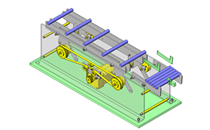(!) Since support from Microsoft will end on January 14 2020, Windows 7 user might not be able to use MISUMI website effectively. Please consider to update your system as ‘MISUMI Website system requirement’.
- แจ้งวันหยุดทำการในเดือน กรกฎาคมและสิงหาคม 2567 | Notice holiday in July and August 2024 > คลิก
MISUMI Small AC Motors
Small AC Motors products in the Automation Components category from MISUMI. The product can be selected based on many product specifications. MISUMI offers products around 0 items and the product specifications can easily be compared. Search and select detailed specifications of parts for your machine with free CAD downloads. MISUMI products are available to order through MISUMI online 24 hours a day. Free shipping, no minimum order.
Application example related to this category
Related Categories to Small AC Motors
FAQ AC Motors
- Question: How does the working principle of a 3-phase induction motor differ from that of a single-phase induction motor?
- Answer: The key difference between these two types of motors lies in the power supply they require. A single-phase induction motor operates on a single alternating current (AC) voltage source, while a 3-phase induction motor requires three separate AC voltage sources with a phase difference of 120 degrees between them. This difference in power supply affects the motor's starting torque, efficiency, and overall performance. 3-phase motors typically provide smoother and more reliable operation, making them suitable for industrial applications, whereas single-phase motors are often used in smaller appliances and machines.
- Question: Between the induction motor and the DC motor, which one is more suitable for variable-speed applications and why?
- Answer: DC motors are generally more suitable for variable-speed applications because their speed can be easily controlled by adjusting the voltage supplied to them. This feature allows precise speed regulation, making DC motors ideal for applications like robotics and conveyor systems. On the other hand, induction motors, especially single-phase ones, are typically less suited for variable-speed control, as their speed is primarily determined by the frequency of the AC power supply.
- Question: How do gear heads contribute to the performance of motors?
- Answer: Gear heads, also known as gearboxes, are often used in conjunction with motors to achieve specific speed and torque requirements. They allow motors to transmit power more efficiently by matching the motor's speed and torque characteristics to the needs of the application. Gear heads can increase output torque, reduce speed, and enhance precision in various automation processes.
- Question: Are there motors with adjustable speed or direction?
- Answer: There are motors designed with adjustable speed and direction control. These motors often incorporate electronic speed controllers (ESCs) or variable frequency drives (VFDs) that allow for precise adjustment of motor speed and the ability to reverse direction. Such motors are commonly used in applications where flexibility and control are essential, such as in conveyor systems, robotics, and industrial machinery.
- Question: What are the typical applications of AC motors?
- Answer: AC motors find widespread use in various applications, including fans, pumps, compressors, conveyor systems, HVAC (heating, ventilation, and air conditioning) units, and industrial machinery. Their versatility, reliability, and ability to operate on AC power grids make them essential in many automation and industrial processes.










How can we improve?
How can we improve?